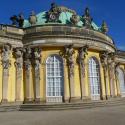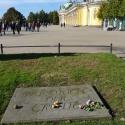Flute Concert at Sanssouci Palace
Françoise Foster-Hahn explains the importance of a contextual understanding of Menzel’s paintings of Friedrich the Great:
“The literature on Menzel (1815-1905) has paid no attention to the historiographic debate surrounding Friederick the Great, nor has it investigated the literary and pictorial sources of Menzel’s work. The present study is based on a systematic analysis of documents, pictorial sources, and contemporary criticism in an effort to establish the precise context of Menzel’s representations. It is above all the close relationship between historiography and art that reveals the meaning of his work. His artistic response and his nascent concept of a historical realism are comprehensible only in the political climate of the 1840’s.”
“The interaction between history, politics, and art not only determined Menzel’s understanding of Frederick as the embodiment of the humanitarian ideals of the Enlightenment but also fundamentally affected the reception of the artist’s works. The transformation in ideology that converted Frederick’s role from that of a champion of enlightened and liberal ideas during the Vormärz* to the powerful precursor of the united Reich after 1871 obscured the meaning of Menzel’s works and betrayed their innovative conception as history paintings. Unrestricted by official patronage and commissions, the artist was free to create his novel images of the Prussian past, and he was inspired, not by academic conventions, but by the vivid and lively traditions of popular art. The sources for Menzel’s historical ‘authenticity’ are found in the early realism of Berlin art – that ‘prosaic Zeitgeist’ [spirit of the time] so severely criticized by Goethe at the beginning of the nineteenth century – and in the naïve, unpretentious images of popular prints, both complemented by a thorough study of history. Thus, without ever minutely copying details, the artist was able to look with unprejudiced eyes at the world of the Rococo, restoring the congenial atmosphere of Frederick’s period that had fallen into disrepute. The realism of Menzel’s historical scenes is based upon his thorough research of history cast into typical and momentary incidents. Menzel rejected the frozen image of the heroic and captured instead the ‘particular, the personal, the individual, the incidental,’ which prompted Kugler to coin the term daguerreotypical reality’ for him. Indeed, this comparison with photography reveals the most characteristic feature of Menzel’s realism. His rendering of history is not elevated to the lofty plane of idealization but projects instead the impact of a snapshot, of documentary photography.”
*Vormärz – ‘before March’ refers to the period between the Congress of Vienna (1815) and the failed March revolution of 1848.
Françoise Foster-Hahn, “Adolph Menzel’s ‘Daguerreotypical’ Image of Frederick the Great: A Liberal Bourgeois Interpretation of German History,” Art Bulletin, vol. 59, no. 2 (June 1977): 242, 261.
About the Artist
Died: Berlin, 9 February 1905
Nationality: German



 Buy the Book
Buy the Book